Blown away - week 2 at Christmas Island
What is it that makes a fishing holiday great? Is it when you land your best fish, or is it when you're exchanging the day's events with your mates around the dinner table, or perhaps it's when you wake up one day and don't actually know what day it is? Well here we are again, it's whateverday, the western world is a million miles away and we're perched on the top of an atoll in the middle of the Pacific Ocean. One week down and one week to go, let's go fishing.
GTs, spawning bones and other species
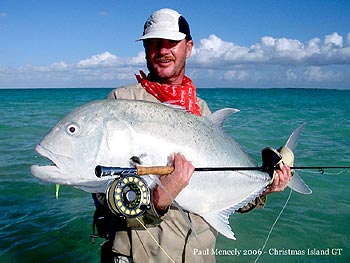 |
Initially the intention was to spend a couple of days chasing bones and a couple chasing GTs. Last year Paul Meneeley managed a 60lb fish on the flats so of course we all got excited prior to the trip with lots of manly talk and discussions on flies, leaders, rods and tactics on how to tame these giant fish. The reality was we actually saw very few GTs and I personally only had shots at 2 fish of around 30lbs on the second last day right in the back of the lagoon, both times the fish spooked when they saw the fly which is strange for GTs as they've usually smashed the fly before you can even start stripping. A couple of smaller 5-10ld trevally were hooked and landed but no giants - others however had some great action but I guess that's just fishing for you.
We waded many flats looking for GTs and travelled to the far corners of the lagoon but saw very few fish. In the first week we ventured offshore twice in the longboats to cast teaser rods with hookless poppers over the back of the reefs that surround Christmas Island, the idea being that either the guide or an angler casts the teaser while the other angler waits with a fly rod ready to cast at anything that follows the teaser in. While we did see some big fish in the 60-80lb range they would smash the popper once and it would be way beyond fly casting distance. I have some unfinished business here.
On the flats, large triggerfish could often be seen with their tails waving about in the air as they rummaged around the coral looking for a feed. Getting one to take a fly however proved very difficult indeed and while a few smaller ones were caught, most of the bigger ones spooked when a fly landed anywhere near them. The fact that they spend most of their life with their heads in the coral means that they're extremely difficult to get a fly in front of.
The few days following a full moon are when large schools of bonefish enter the lagoon to spawn. On the moving tides they can be seen in schools of up to a few hundred fish, seen as a grey clouds slowly moving across the deeper sections of the flats. A long cast in front of a school like this and it'll only be a matter of 2 or 3 strips and you'll be hooked up. Even at the back of the lagoon we found large schools of cruising bones.
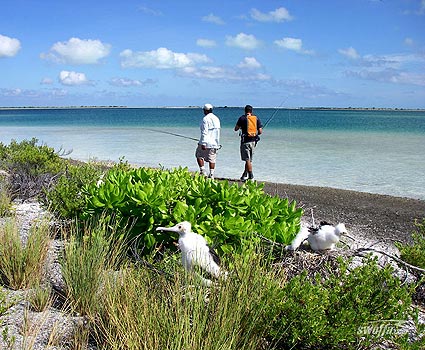 |
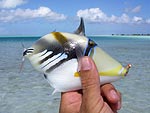 |
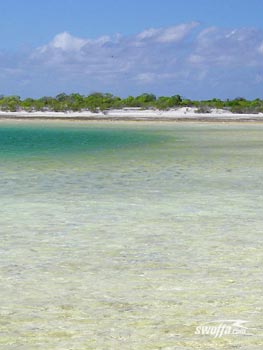 |
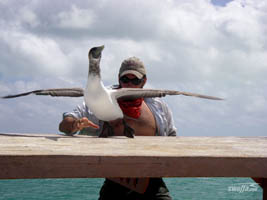 |
||
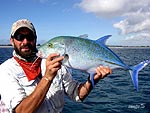 |
Welcome Corin
My angling partner for the second week was friend and global fly-fisherman Corin Smith who arrived on the morning that the others were leaving. At lunch we said our goodbyes to half the group and the 2 of us decided to head offshore to chase some of the yellowfin that I obviously couldn't stop talking about. The wind was howling offshore but we decided to head out -what the heck, Corin was itching to catch a fish and so was I.
We magically had 2 new boatmen as it was a new week and a new roster of guides and boatmen so all the lessons learned from the past few days chasing these fish was now sleeping under a palm tree somewhere. It was back to square one with the boat dudes learning to position 2 swoffers into within casting range of the fish.
Corin's first draw from the quiver of rods that he'd brought along was his 10wt. That turned out to be a bad move as his first yellowfin put some serious hurt on his back - the rod was a little too light to lift the fish. Check out this kneeling action from the outrigger.
Fishing proved extremely difficult with relentless wind and swell making casting and boat handling a mission. It was frustrating to say the least because at times we'd be downwind of the school with fish going nuts directly upwind and the motor in neutral, boat dude watching the guide for his next set of instructions. You see that's how it is here; the guide gives instructions by hand to where he wants the boat dude to go. We would give instructions to the guides and they would in turn translate those into hand signals. Although most Islanders can understand English, communication was at times very basic.
Tuna move fast, one too many false casts or a badly timed approach and it's a missed opportunity. We had plenty of those as the longboats could only turn really slowly and by the time we got into position, quite often the fish had moved on already. After chasing the schools for most of the afternoon in difficult conditions, we each managed to land a single yellowfin.
What a great way to start Corin's week and as the sun touched the horizon we stopped fishing to head home. Spirits were high.
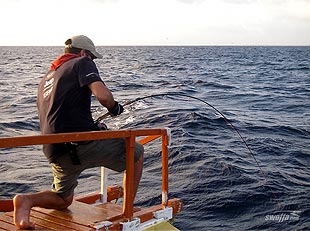
|
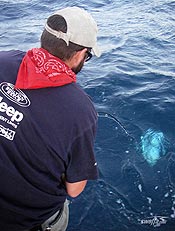
|
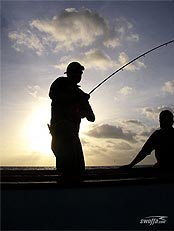
|
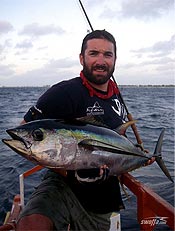
|
Getting blown away
Things soon took an abrupt turn when on the way back we ran out of fuel from one tank. No drama we had another tank so the boat dude calmly attached the second tank and proceeded to pull start the 40 hp motor to get fuel circulated through the carburettor. I remember watching him when in slow motion the starter rope broke!
I moved to the back of the boat and removed the engine cowling and by using my digital camera's screen as a light could just see a few inches of rope sticking out from under the fly-wheel, so I fed it back through the feeder and re-attached another piece of rope. The boat dude starts pulling again and after 2 pulls, the rope broke again, only this time it broke right inside the fly wheel - now we can't start the motor! By now it's well and truly dusk with the light all but gone, the first stars were out and the moon wasn't up yet so there was zero light to see anything. The wind was still pumping and we knew we were slowly being blown out to sea.
Boat dude 1 quickly informs boat dude 2 to put the anchor out which he does. He throws it over the side, big splash then the worst silence I've heard for a long time. It wasn't attached to anything - he just threw the anchor overboard! I recall him rattling something off in Gilbertese which we later learned translated into "We are now in danger!" Oh shit!
Instantly I could feel the cold grip of fear come over me, it was a horrible, helpless feeling. We're now about 2km offshore, it's dark, no-one knows where we are, we have zero safety gear - we have no flares, no radio, no water, no life jackets, a single outboard with a bust starter rope, no anchor and we're in the lee of an island in the middle of the Pacific being blown out to sea in a howling gale. This is not good.
One of the boat dudes tore a piece of cloth and wrapped it around the back of the gaff, and started pouring petrol over it. We couldn't see a thing as there were no lights and these dudes were pouring petrol in an open wooden boat in a 20 knot wind, rocking back and forth in the ocean. When he eventually lit it, half the gaff was covered in fuel and was alight for a few seconds - immediately the boat was illuminated with a wash of red and yellow light as he waved the flaming torch overhead in the hope that anyone would see us. The flame didn't last long and soon burnt out so Corin and I took turns at flashing our digital cameras in the general direction of the land hoping that someone would see us. It proved pointless because no one came. This is the last pic that I took on my camera before the battery died.

|
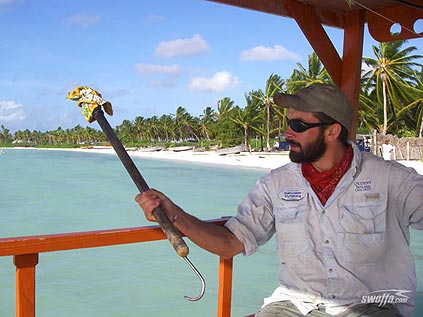
|
Corin pulled out two small 2-way radios that he'd brought along and when the boat dudes saw these they said 'Channel 16' - he flicked between the channels, squinting his eyes at the small screen in the pitch black of night 'mayday, mayday, mayday' ... nothing.
As we all sat there in silence, the lights from land getting further and further away, I remember Corin asking head guide Teanaki if there were sharks in these waters - I quickly said 'don't even think of it dude'.
Teanaki was confident that he could fix the engine but it would just take time. There was a shortage of spark plugs on the island so first he said he needed to clean them. I handed him a piece of single strand wire and sat there with my head in my hands as Corin flashed another pic into the darkness. With the cowling off and the engine exposed, he dangled off the back of the boat in pitch darkness and proceeded to remove each of the spark plugs one by one.
It's so hard to think in a situation like this - what if he drops something overboard, what if the pliers slip, what if he looses a sparkplug? If something did drop overboard, we'd be completely stuffed if we were still there in the morning. I suggested we sat it out and waited until someone found us or until morning when we could see properly but he replied 'what if we can't see land in the morning?'
Operating by feel only he slowly removed each of the spark plugs cleaned it with a piece of single strand leader wire and returned it. It seemed like forever, the worst thoughts were going through my head and no one was saying anything. At one stage we saw some lights of what could have been a boat so we all began whistling and shouting but it wasn't anything. More silence.
At about 9pm and having been in the pitch dark for over 2 hours drifting further away from land, Teanaki managed to remove the fly wheel cover with a pair of pliers and with a piece of anchor rope that he'd wrapped around the exposed fly wheel, he got the engine started. God what a good sound that was to hear the engine kick over!
We slowly limped back into the lagoon with the engine cover off and as we neared London the engine suddenly stopped again. Luckily we were already in the lagoon and after a few minutes the boat was blown ashore. The guide knew someone close by so he ran off and returned 15 mins later in his truck so we loaded all our gear and were taken back to the hotel where understandably, the rest of the group were waiting extremely concerned. The local Police service had already been notified but with no rescue service on the Island there's not much they could have done other than to notify Hawaii Coast Guard who are 2,000km away.
This little incident is no one's fault, it was a bunch of unfortunate errors that occurred at the same time and could have happened to anyone at any time. We accepted the risks involved in what we were doing and it was our choice to be out there, fortunately things worked out ok and we all returned safely to land. A good lesson was learned from this and our group has since assisted the islanders by guiding them towards some improved safety standards including life jackets, flares, 2 way radios, extra water and a backup motor if guests request to fish offshore.
Teanaki said "You know, if you play ... sometimes you can get hurt ... that's life"
Sailfish circling the Yellowfin!
After our little incident we had a day's break catching bones in the lagoon, giving our nerves enough time to settle and the boat dudes enough time to fix the engine. So early the following morning we ventured offshore again, only this time in search of larger pelagics like sailfish and wahoo. We'd seen a large free-swimming sailfish next to one of the tuna schools a couple of days before but unfortunately weren't quick enough to get a shot at it. After breakfast we explained to Teanaki that we wanted to target a sailfish and how, in a perfect world, things should go on the boat if one came up on the teaser. While in his 24 years as a guide he'd put many clients onto sails using conventional gear or trolling the fly, he'd never had a client actually cast the fly at one before. This was new and he was very excited and willing to try. We were all learning - I've never even seen a sailfish, let alone cast to one.
We discussed that if the fish hits the teaser then someone grabs the rod and slowly reels the fish closer while the boat driver slows the boat down. As it comes closer getting more frustrated trying to eat the hookless teaser, one of us will cast the fly at it and when it's within casting distance off the back of the boat, the teaser is pulled from the water and the angler takes a shot with the fly. That's in a perfect world, however our situation was challenging from the start; there's a boat driver sitting in your way, 4 tanks of fuel at your feet, large holes in the slatted wooden floor and an outrigger on your right side that makes casting right handed pretty challenging. Those who have been to Christmas Island and have seen these boats will know what I mean.
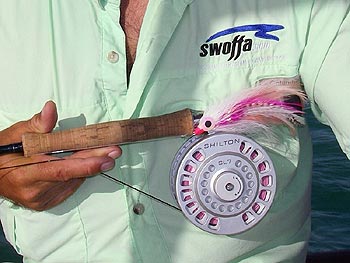
|
We both had teaser rods loaded with 50lb braid and as we left the lagoon both were skimming along behind the boat with hookless poppers. The plan was to head south and follow the coast down past Poland and around the corner where the island literally drops straight off the reef into a thousand fathoms of water. Corin kindly allowed me to take the first shot if we raised one so I stretched my line and laid it neatly on the floor, rod and fly in hand, eyes locked on the teasers - waiting. Teanaki suggested pink as the preferred colour so on went one of my big 6/0 'flange' flies.
While on the way from a distance we could see the clouds of birds on the horizon moving across the ocean in what looked like a kind of dark swarming vortex. The tuna were up again and they were going absolutely berserk. It's impossible to drive past this many fish with 2 swoffing nuts on the boat so we headed towards the action and as we approached the school, a sailfish hit one of the teasers. Pandemonium ensued; no one was expecting it and the fish disappeared as quickly as it arrived.
We continued circling the school and it wasn't long before the other teaser was annihilated by a monster yellowfin tuna. A plume of white water ripped deep into the ocean as the fish dived down pulling line off the reel as it dived down with the teaser in its mouth. It was crazy action and quickly the teasers were pulled in and we were soon standing front and back of the boat pelting flies into the ensuing carnage. The weather remained perfect and by now the boat driver was getting us into position straight away, giving us some great shots. After a couple of fish each and a double hook-up, we left the tuna still feeding hard and decided to move off in search of the larger hungry pelagics.
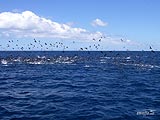 |
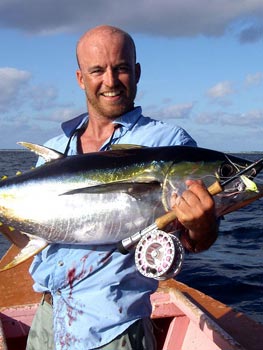 |
|
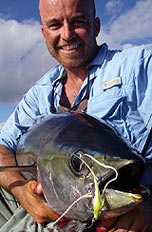 |
The longboat slowly trolled the teasers around the point of Poland and then around another point and then another. We were miles from home, conditions were perfect with a light 5-10 knot wind and clear blue skies - we knew it was only a matter of time before the next fish would raise from the depths and hit the teaser.
By midday we'd raised 4 sailfish, 3 of them just hitting the teaser with their beaks once and then diving again. One fish however followed the teaser in and we had the shot. Watching the big fish swimming towards the boat was amazing, its bill clearly out of the water swatting from side to side as it kicked its tail to keep up with the boat. Teanaki grabbed the rod and slowly brought the teaser and excited fish towards the boat as the boat dude slowed us down. Straddling boat boy and fuel tanks, I stood up and with a couple of false casts dropped the fly to the side of the fish just as Teanaki ripped the teaser away. When the fly landed my rod was already under my arm and I began a quick double handed retrieve with the pink fly sticking out like mutt's nuts in the dark blue water. The fish was lit up and it swerved, turning cleanly onto the fly and two strips later the 6/0 hook was wedged firmly into 8ft of enraged sailfish.
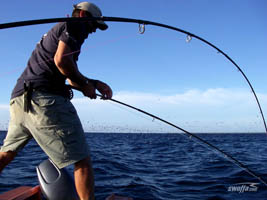 |
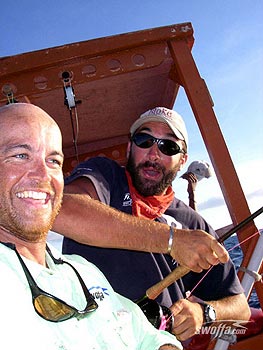 |
|
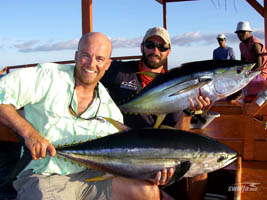 |
||
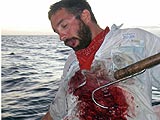 |
"Man that's a big sailie" Corin said as the fish took off across the ocean in an amazing aerial display of leaps, line melting off the reel as the fish tore around with my pink fly firmly visible in it's bill. The fish was amazingly strong and had no trouble pulling line from the reel with long, powerful runs from side to side, then turning and running hard, then coming towards me, rod up, rod down, then straight down - the whole experience at once. All I could do was hold on as the fish went mad and pure adrenaline streamed through my body. Man this thing was strong, it was easily the biggest and strongest fish that I've ever been connected to, no doubt.
Half and hour into the fight the fish was straight below us and I was still way into the backing, the rod was bent right down to the cork and it was another 20 minutes of pumping and winding before we realised that the line had actually wrapped around its tail. The poor fish was slowly pulled up backwards from 150m down and when it came to the surface it was very, very tired. 'Please don't die, please don't die' - I was so worried the magnificent fish would die, however I think the boat dudes may have thought otherwise. A couple of quick pics were taken and we spent the next 10 mins hanging over the side of the moving boat holding the bill, flushing water into its open mouth. I honestly thought it was dead as it wasn't moving but after a few minutes I felt its jaw clamp down slightly as it slowly regained its colour and strength. When I let it go, it slowly disappeared back to wherever it came from, alive.
It was my first sailfish and the biggest fish I've ever landed on a fly rod. In the end the teamwork on the boat went like clockwork, everything had gone according to plan on the first attempt and collectively we pushed the swoffing envelope a little further. Funny how it was only 2 days earlier that we were in the very same wooden boat being helplessly blown out to sea in the dark by a howling gale. Today was a very good day indeed.
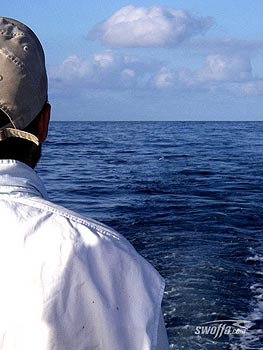 |
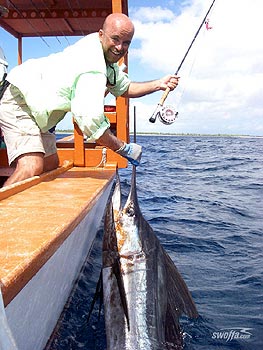 |
Did you enjoy this article?
Send this article to a friendSend us your comments
Subscribe to swoffa.com
